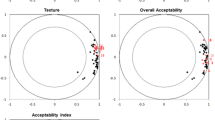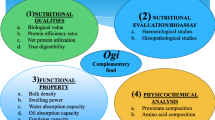Abstract
The proximate composition, acceptability and nutritional properties of akara produced from cowpeas (Vigna unguiculata) and white maize (Zea mays) flour blends in the ratios 100:0 (Sample A, control), 85:15 (sample B), 75:25 (sample C), 65:35 (sample D), 50:50 (sample E), 40:60 (sample F), and 30:70 (sample G), respectively, were investigated. Protein quality was evaluated by feeding 28 day-old weanling albino rats with 10% protein diets formulated with samples A to G, with casein as the control diet. Crude protein, fat and moisture contents of the all-cowpea akara, were 20.7%, 22.4% and 38.9%, respectively, but decreased to 15.8%, 16.5% and 17.5%, respectively, when the level of maize flour in the blend increased to 70%. Up to 35% maize flour in the blend produced acceptable akara, with ball shape, color and flavor similar to the control. There were no significant (p > 0.05) differences between the values obtained for protein efficiency ratio, net protein ratio, and apparent and true digestibilities of diet G and casein when fed to rats, suggesting an improvement in the protein quality of akara prepared from cowpea: maize (30:70 w/w) flour blend, but at the expense of acceptability.
Similar content being viewed by others
References
Oyenuga VA (1978) Nigeria's foods and feeding stuffs. Their chemistry and nutritive value. Ibadan: University Press.
Dovlo FE, Williams CE, Zoaka L (1976) Cowpea: home preparation and use in West Africa. Ottawa, Canada: International Development Research Centre, Publication IDRC-055e p. 57.
Uwaegbute AC (1991) Weaning practices and weaning foods of the Hausas, Yorubas and Ibos of Nigeria. Ecol Food Nutr 26: 139–153.
Reber EF, Eboh L, Aladeselu A, Brown WA, Marshall DD (1983) Development of high-protein low-cost Nigerian foods. J Food Sci 48: 217–219.
McWatters KH, Resurreccion AVA, Fletcher SM (1990) Response of American consumers to akara, a traditional West African food made from cowpea paste. Int J Food Sci Technol 25: 551–557.
McWatters KH, Frank F (1980) A deep-fried product from southern peas Food Technol 34: 71–74
McWatters KH, Chinnan MS, Hung YC, Branch AL (1988) Effect of predecortification drying temperature on cowpea paste characteristics and functionality in preparation of akara Cereal Chem 65: 23–27.
Hung YC, McWatters KH (1990) Effect of holding time on the functionality of cowpea paste and quality of akara. J Food Sci 55: 558–559.
Alobo AP (1999) Production and organoleptic assessment of akara from bambara groundnut (Voandzeia subterranean L.) Thours Plant Foods Hum Nutr 53: 313–320.
McWatters KH (1983) Compositional, physical and sensory characteristics of ‘akara’ processed from cowpea paste and Nigerian cowpea flour. Cereal Chem 60: 333–336.
Ngoddy PO, Enwere NJ, Onuorah VI (1986) Cowpea flour performance in akara and moin-moin preparations. Trop Sci 26: 101–119.
Giami SY (1993) Effect of processing on the proximate composition and functional properties of cowpea (Vigna unguiculata) flour Food Chem 47: 153–158.
Bressani R, Valiente AT, Tejada CE (1962) All-vegetable protein mixtures for human feeding vi. The value of combinations of lime-treated corn and cooked black beans J Food Sci 27: 394–399.
Ossai GEA, Malomo O (1988) Nutritional and sensory evaluation of a newcereal-legume weaning food. Nigeria Food J 6: 23–34.
Oyeleke OA (1992) Utilization of protein and energy from cooked maize: legume dishes in growing rats compared with a traditional Nigerian dish. Int J Food Sci Technol 27: 229–233.
Akpapunam MA (1985) Characteristics of moin-moin flour prepared from cowpea/maize blends Nigeria Food J 3: 207–208.
Odum PK, Adamson LA, Moragne L, Edwards CH (1981) A weaning food from locally grown grains in Nigeria: formulation and organoleptic evaluation. Nutr Rep Int 23: 1005–1019.
AOAC (1984) Official methods of analysis, 14th edn. Washington, DC: Association of Official Analytical Chemists.
Larmond E (1977) Laboratory methods for sensory evaluation of foods, Canada: Department of Agriculture, pp 33–37, 57.
Achinewhu SC, Isichei MO (1990) The nutritional evaluation of fermented fluted pumpkin seeds (Telfairia occidentalis Hook). Discovery and Innovation 2: 62–65.
Pellet PL, Young VR (1980) Nutritional evaluation of protein foods. UNUWorld hunger program. Food Nutr Bull Supplement No. 4.
Wahua TAT (1999) Applied statistics for Scientific Studies. Aba, Nigeria: African-Link press.
Umoh V, Fields M (1981) Fermentation of corn for Nigeria agidi. J Food Sci 46: 903–905.
McWatters KH (1985) Functionality of cowpea meal and flour in selected foods. in: Singh SR, Rachie KO (eds), cowpea research, production and utilization. NewYork: John Wiley, pp 361–366.
Author information
Authors and Affiliations
Rights and permissions
About this article
Cite this article
Giami, S., Akusu, M. & Jaja, I. Production, organoleptic assessment and nutritional properties of akara from cowpea/maize flour blends. Plant Foods Hum Nutr 58, 1–9 (2003). https://doi.org/10.1023/B:QUAL.0000041150.87983.4e
Issue Date:
DOI: https://doi.org/10.1023/B:QUAL.0000041150.87983.4e




